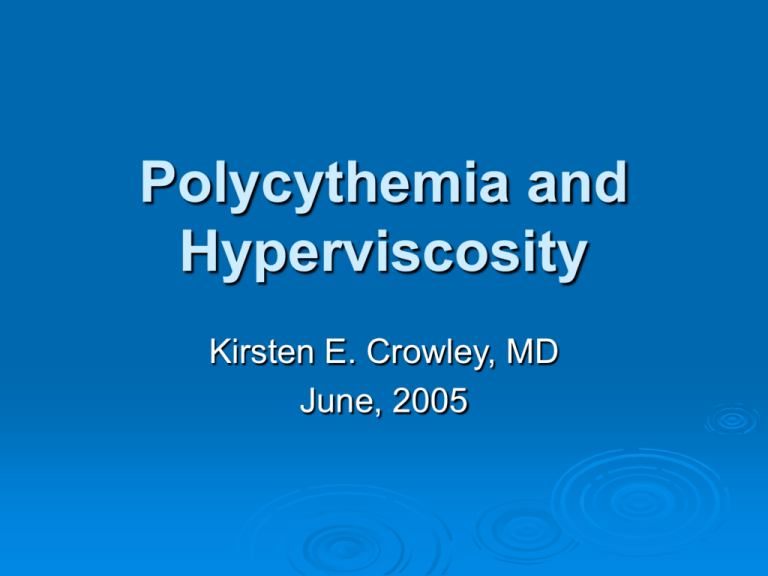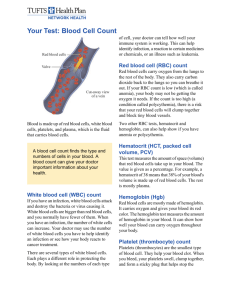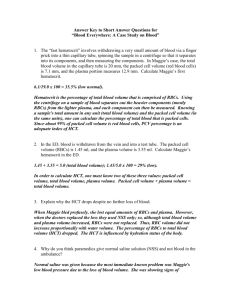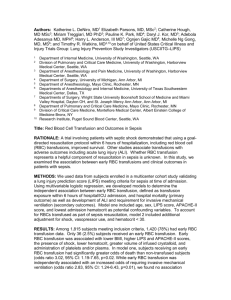Polycythemia and Hyperviscosity
advertisement

Polycythemia and Hyperviscosity Kirsten E. Crowley, MD June, 2005 Definitions Polycythemia is increased total RBC mass Central venous hematocrit > 65% • Above 65% blood viscosity rises exponentially Polycythemic hyperviscosity is increased viscosity of the blood resulting from increased numbers of RBCs Not all polycythemic infants have symptoms of hyperviscosity Incidence Polycythemia occurs in 2-4% of newborns Half of these are symptomatic Hyperviscosity occurs in 25% of infants with hematocrit 60-64% Hyperviscosity without polycythmia occurs in 1% (nonpolycythemic hyperviscosity) Pathophysiology Clinical signs result from regional effects of hyperviscosity and from the formation of microthrombi Tissue hypoxia Acidosis Hypoglycemia Organs affected: CNS, kidneys, adrenals, cardiopulmonary system, GI tract What affects hyperviscosity? Hematocrit Increased hct is the most important single factor Results from increase in circulating RBCs or decreased plasma volume (dehydration) Plasma viscosity Higher plasma proteins = increased viscosity • Especially fibrinogen (typically low in neonates) RBC aggregation Not usually an issue in neonates Occurs in areas of low blood flow = venous microcirculation Not a large factor in neonates Deformability of RBC membrane: usually normal Conditions that alter incidence Altitude: increased RBC mass Neonatal age Physiologic increase in hematocrit due to fluid shifts away from intravascular compartment with maximum at 2-4 hours of age Obstetric factors: delayed cord clamping or “stripping” of the umbilical cord High-risk delivery, especially if precipitous Perinatal processes Enhanced fetal erythropoiesis usually related to fetal hypoxia Placental insufficiency • Maternal hypertension, abruption, post-dates, IUGR, maternal smoking Endocrine disorders: due to increased oxygen consumption • IDM (>40% incidence), congenital thyrotoxicosis, CAH, Beckwith-Wiedemann syndrome (hyperinsulinism) Hypertransfusion Delayed cord clamping • Placental vessels contain 1/3 of the fetal blood volume, half of which will be returned within 1 minute Gravity: positioning below the placenta will increase placental transfusion Meds: oxytocin can increase contractions and thus transfusion • Decreased in c-section b/c no contractions Twin-twin transfusion Maternal-fetal transfusion Intrapartum asphyxia • Enhances net umbilical flow toward the infant, while acidosis increases capillary leak leading to reduced plasma volume Clinical presentation Symptoms are non-specific! CNS: lethargy, hyperirritability, proximal muscle hypotonia, vasomotor instability, vomiting, seizures, cerebral infarction (rare) Cardiopulmonary: respiratory distress, tachycardia, CHF, pulmonary hypertension GI: feeding intolerance, sometimes NEC GU: oliguria, ARF, renal vein thrombosis, priapism Metabolic: hypo-glycemia/-calcemia/magnesemia Heme: hyperbili, thrombocytopenia Skin: ruddiness Diagnosis Central venous hematocrit > 65% ALWAYS draw a central venous sample if the capillary hematocrit is > 65% Warmed capillary hematrocrit > 65% only suggestive of polycythemia Management Asymptomatic infants Expectant observation unless central venous hematocrit >75% (consider partial exchange transfusion) Can do a trial of rehydration over 6-8 hr if dehydrated • Usually at > 48 hours of age and weight loss > 8-10% • Give 130-150 ml/kg/d Check central hematocrit q6 hours • Normal peak is at 2-4 hours of age for acute polycythemia Management Symptomatic infants with central hct > 65% Partial exchange transfusion is advisable but debatable For exchange can use normal saline, Plasmanate, 5% albumin, or FFP Volume exchanged = • (Weight (kg) x blood volume) x (hct - desired hct) / hct Blood volume is 80 ml/kg Exchange can be done via UVC that is not in the liver, low UAC, or PIV Other labs to check Serum glucose Serum bilirubin Increased bili due to increased RBC turnover Serum sodium, BUN, urine specific gravity Hypoglycemia is common with polycythemia Usually high if baby is deyhdrated Blood gas to rule-out inadequate oxygenation as cause of symptoms Platelets, as thyrombocytopenia can be present Serum calcium b/c hypocalcemia can be seen Prognosis Increased risk of GI disorders and NEC with partial exchange transfusion (PET) Older trials show decreased neurologic complications from hyperviscosity with PET, but newer trials show no real benefit PET is controversial! Infants with asymptomatic polycythemia have an increased risk for neurologic sequelae Normocythemic controls with the same perinatal history have a similarly increased risk










